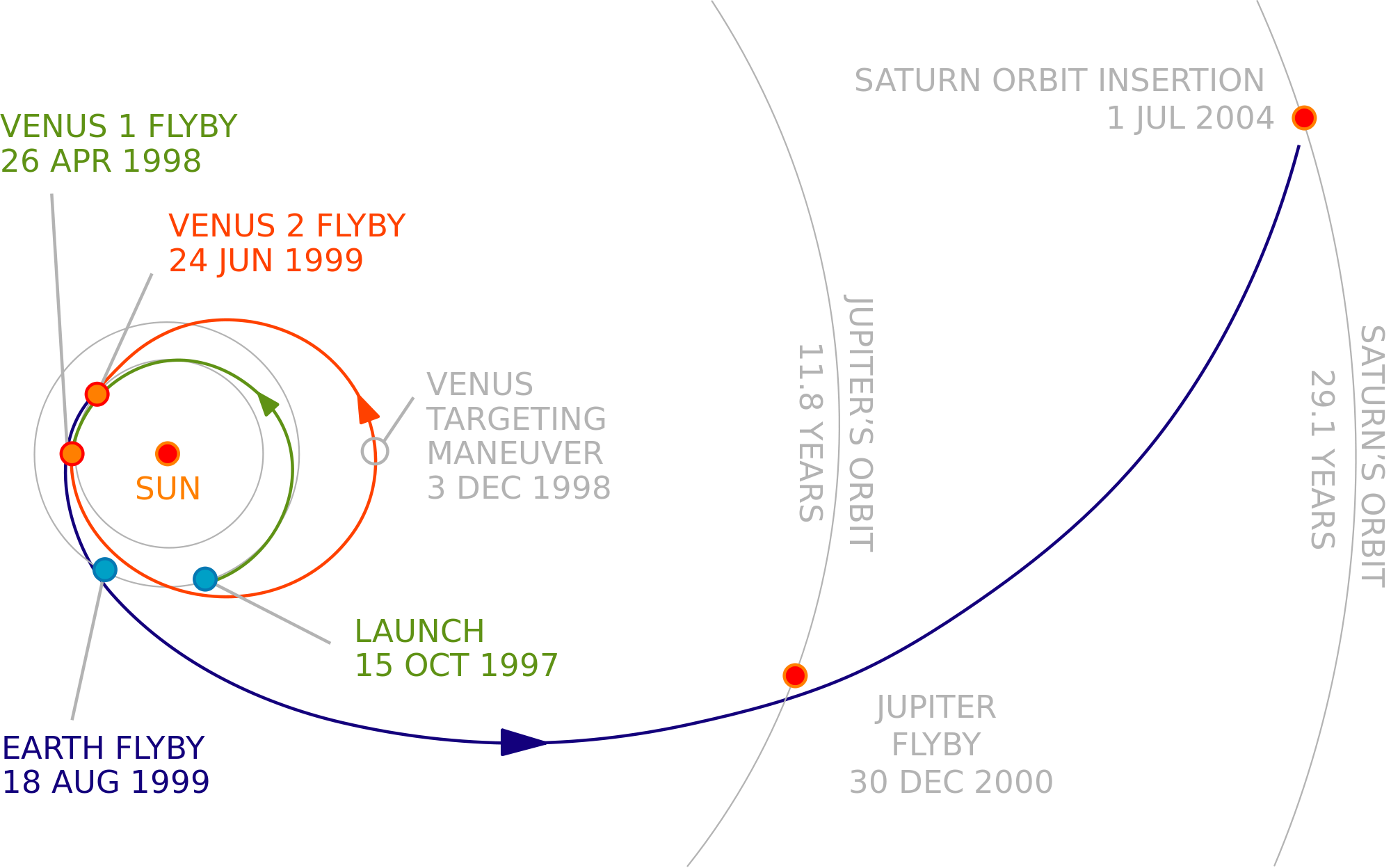News | June 8, 2017
Scenic Route to Saturn

This graphic depicts Cassini's interplanetary route beginning with launch from Earth, followed by gravity assist flybys of Venus, Earth, and Jupiter. During each flyby, orbital momentum was transferred from each planet to the spacecraft, increasing the spacecraft's velocity relative to the sun so Cassini could reach Saturn.
In August of 1999, Cassini flew within 720 miles (1,160 kilometers) of Earth. The spacecraft had launched in 1997 bound for Saturn, and spent nearly two years traveling more than a billion miles (1.6 billion kilometers) — roughly equal to the distance from Earth to Saturn — and yet the spacecraft was now so close to Earth that it was visible at night from some islands in the South Pacific.
Cassini hadn’t misplaced her map. It’s just that sometimes the scenic route is the only route available.
It takes a lot of propellant (fuel and oxidizer) in a big rocket to get anything moving fast enough to stay in Earth orbit instead of falling back to Earth. To travel beyond orbit and escape Earth’s gravity altogether, a more powerful rocket is needed. But once a spacecraft escapes Earth’s gravity, it then has the sun’s gravity to contend with, so to travel outward — away from the sun — a spacecraft needs an even more powerful rocket.
In short, the farther you want an object to go, the faster it needs to travel and so the more powerful its rocket needs to be. That applies even if the thing being launched into space is only a sack of potatoes. And Cassini is no sack of potatoes.
Cassini is one of the most massive spacecraft ever flung into the outer solar system. With full tanks, and with the European Space Agency’s Huygens probe attached, the spacecraft weighed 12,593 pounds (5,712 kilograms) and is 22 feet (6.7 meters) high by 13.1 feet (4 meters) wide. “Cassini is a giant,” said Charley Kohlhase, formerly Cassini’s Science and Mission Design Manager, now retired. “It’s the size of a school bus.”
If Cassini had been launched directly at Saturn on the most powerful U.S. launch vehicle at the time, the spacecraft would have slowed and eventually stopped before falling back toward the sun. So mission designers came up with a solution called the Venus-Venus-Earth-Jupiter Gravity Assist, or VVEJGA for short, which Kohlhase pronounces “vee-VEJ-kuh.”
Because the planets are in motion, they have momentum, so Cassini would fly by Venus twice, Earth once, and then Jupiter, transferring some of each planet’s orbital momentum to the spacecraft, which accelerates as a consequence.
After launch, Cassini traveled not outward toward Saturn, but inward, around the sun in the same direction that the planets orbit. Eventually, the spacecraft caught up to Venus. As Cassini neared the planet, the mass of the spacecraft and the mass of the planet pulled on one another gravitationally. Since Cassini was following the planet, Venus slowed while Cassini sped up. That is, Venus now travels more slowly along its orbit of the sun than it used to. But because the planet’s mass is so much greater than the spacecraft’s, the planet slowed down so little that no one will never notice, and the spacecraft sped up a lot.
The funny thing about speed is that it exists only relative to something else, and Cassini’s speed relative to Venus was no different after the flyby than before. “There’s no net speed gain relative to the assisting body,” Kohlhase said, referring to Venus. However, relative to the sun, which can be thought of as the solar system’s shared point of reference, the spacecraft had accelerated by 13,400 miles per hour (about 6 kilometers per second). That was April 1998, and Cassini was just getting started.
Cassini then traveled around the sun again and performed a second gravity assist with Venus in June 1999 for more acceleration, followed by an August 1999 flyby of Earth, which gave the spacecraft a boost of 13,400 miles per hour (6 kilometers per second) relative to the sun.
Cassini then flew past Jupiter on Dec. 30, 2000. The previous three flybys were all within several hundred miles of the planets’ surfaces, but Cassini flew by Jupiter about 6 million miles (9.7 million kilometers) from the planet. Despite that great distance, the Jupiter gravity assist still provided Cassini with a speed boost of about 4,500 miles per hour (about 2 kilometers per second).
Even with all that stolen momentum, Cassini still spent nearly seven years traveling from Earth to Saturn. “It was the only way,” Kohlhase said. “Cassini’s mass was so large that we couldn’t have gotten to Saturn without VVEJGA.”
Cassini has since changed human understanding about the Saturn system during its 13 years orbiting the ringed planet. And because of the VVEJGA trajectory, Cassini also left its gravitational mark on the orbits of the planets it flew by, including even our solar system’s largest known planet, said Kohlhase. “Jupiter was slowed down by about one foot per 10 trillion years.”
